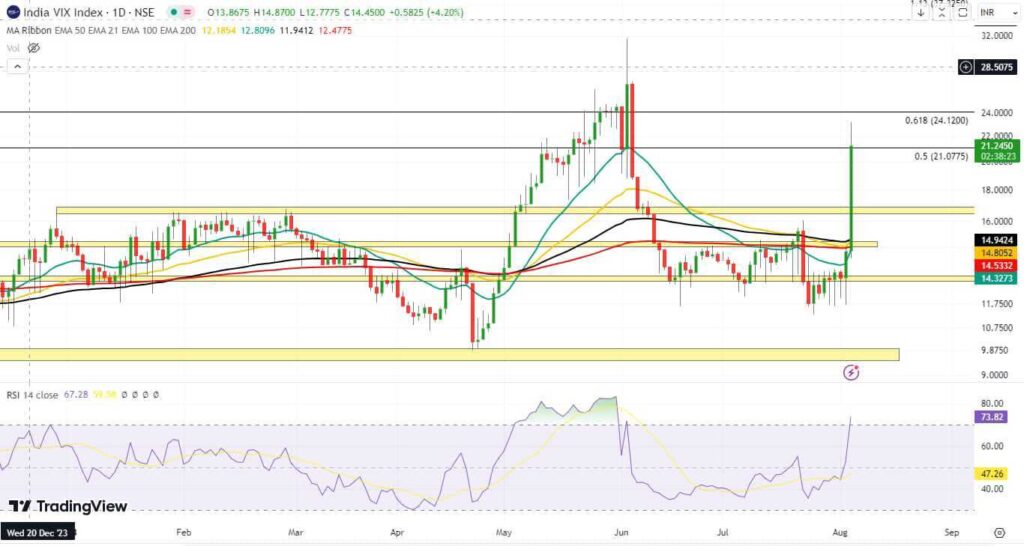The India VIX, the volatility index shot up 60% on Monday amid a market meltdown across the Indian and global markets.
What Happened: India VIX rallied 61.66% to an intraday high of 23.15 on Monday as global markets fell due to recessionary concerns in the US. Nifty 50 had fallen 3.21% to 23,925.20 by Monday afternoon. Asian Peers such as Nikkei 225 fell 12.4% to 31,458.42, having its worst day since the Black Monday of 1987.
The volatility index shows investors’ expectations of market volatility over the next 30 days. There is an inverse correlation between VIX and Nifty. When the Nifty falls, the VIX rises.
The surge in the volatility index was the highest since the election results day when the index shot up 51% to the 31.71 mark.
Analyst Views: Anand James, chief market strategist, Geojit Financial Services said, “VIX was not far from record low recently, which magnified the rate of rise today. In absolute terms, we are still way below the VIX seen around the election results. Single-day spikes in VIX are usually seen corrected quickly. For now, given the present VIX, the 50-day SMA at 23,860 seems enough to support Nifty, but VIX's close beyond 27 could change all that.”
See Also: Why Are Defence Stocks HAL, Mazagon Dock, BDL Facing Rout On Exchanges?
“Recently, the India VIX formed a triple bottom pattern around the 11-12 zone. This technical formation often signals a potential reversal in trend, especially when accompanied by a bullish divergence on the Relative Strength Index (RSI) on the daily chart. A bullish divergence occurs when the RSI forms higher lows while the price forms lower lows, indicating a potential bullish reversal. Following these signals, the India VIX experienced a substantial increase of 50%, reaching a level near 22. In terms of short-term movements, support is anticipated around the 18 and 17 levels, meaning these points could provide a floor for the index if it declines.
Conversely, resistance is expected at 24, with a stronger barrier at 25, suggesting these levels could cap further upward movements. If the India VIX closes below 20 on a daily scale, it could indicate a temporary decrease in volatility, suggesting a possible cooling-off period. Therefore, in the near term, the India VIX is likely to fluctuate within a range of 17 to 24, barring any significant market developments.” Jigar S Patel, senior manager – technical research analyst, Anand Rathi Shares and Stock Brokers said.

Anshul Jain, head of research at Lakshmishree said, “The India VIX has taken support at its long-term base of 11.5 and has sharply rebounded, doubling in a single day to 21.6—a significant 50% rise. This substantial increase in the India VIX indicates a clear rise in volatility, which will have a butterfly effect on option pricing and index volatility.
Given that the India VIX is negatively correlated with the markets, the index is currently under pressure and at key support levels. If the India VIX breaks out of its pattern at 23, the index is likely to decline sharply. Conversely, if the index finds support at the critical level of 24,000, the VIX may cool off. However, the probability of the VIX rising remains high. Therefore, in the short term, we are bullish on the VIX and bearish on the index.”
Read Next: Ola Electric IPO: These Early Investors Set To Lose ₹6 Cr On Their Investments
Don't miss a beat on the share market. Get real-time updates on top stock movers and trading ideas on Benzinga India Telegram channel.
© 2024 Benzinga.com. Benzinga does not provide investment advice. All rights reserved.